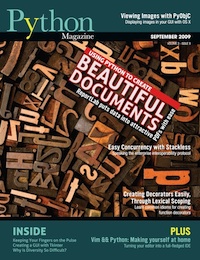
The September issue of Python Magazine appeared on the web late last week and only now, as a new week has started, am I finally sitting down to announce it! The articles range from technically heavy development topics to high-level thoughts about the whole Python community, with plenty in between.
I have to say that our prettiest article this month is “Using Python to Create Beautiful Documents” by Yusdi Santoso, who shares the basic secrets to document generation that he learned when building the EuroPython 2009 brochure using a Python program. Traditional typesetting and computer typography were both interests of mine when I was growing up, so it was fun to read Yusdi's introduction to using ReportLab to generate PDF documents. I look forward to his follow-up article that we will soon be publishing, on the specific techniques that he used in creating the EuroPython booklet.
The other technical articles are an introduction to using SOAP in Python; a guide to displaying objects in a Mac OS X GUI created with PyObjC; an article introducing Python's own built-in Tkinter GUI toolkit; and a small excursion of my own that attempts to explain the popular “trick” (well, it really confused me the first time I saw it!) of defining a decorator using a pair of nested functions. I should confess that my own article contains what is probably this issue's biggest mistake, as pointed out quite promptly by alert reader Emanuel Woiski: in the code sample that is its whole crux of my example, I somehow managed to omit one of the most crucial lines, shown here in bold:
def log(function):
def log_wrapper(*args):
print "called %s%s" % (
function.__name__, tuple(args)
)
return function(*args)
return log_wrapper
I suppose I will now need remedial cut-and-paste training of some sort.
Finally, the issue is rounded out by three articles that move back from Python coding and step out to wider vantage points. Justin Lilly provides an excellent guide to customizing your Vim setup so that it becomes a powerful Python integrated development environment. Steve Holden muses about why diveristy is so difficult and reveals some of the recent goings-on surrounding the diversity statement that the Python Software Foundation has been working on. And my own editorial seeks to point any Python Magazine readers who do not yet have a strong connection with the wider community in the direction of greater engagement with the world of Python.
All in all, I think the issue is a nice mix of fact, experience, and opinion. Please consider subscribing if you would like to hear more about what people are doing with Python, and how. I enjoy reading it; so might you.